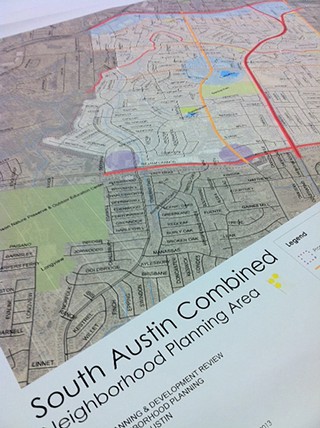Then There's This: Southland
Seven neighborhoods take Imagine Austin on a test run
By Amy Smith, Fri., Jan. 18, 2013
Last Saturday morning, more than 130 South Austin residents walked through the doors of the Crockett High School cafeteria to ponder the future of their neighborhood. The turnout on this damp morning might have been lighter than what city planners had anticipated, but the significance of the Saturday confab was not lost on those who showed up: The South Austin Combined Neighborhood Plan is the first such process to be developed under the new Imagine Austin Comprehensive Plan, a blueprint for how the city will grow.
As such, seven South Austin neighborhoods will help determine the look and feel of their stomping grounds within the boundaries of Ben White Boulevard and William Cannon, and South First Street and Westgate Boulevard. Like many neighborhoods, this area holds a fair share of vacant lots and storefronts, as well as rundown structures along commercial corridors that are being eyed for redevelopment. Residents will have a say in how and where new development and infrastructure fixes gets accomplished. Ranking high on the list of "don't-change-a-thing" items is the vast canopy of mature trees that serve as one of the area's most valued and enviable assets.
In the long run, the planning process will serve as an interesting test case for how Imagine Austin achieves its long-term goals – introducing and creating "complete communities" that are compact, sustainable, affordable, and connected, among other things. (See an image of the planning area within the context of the Imagine Austin growth concept map.)
Now, you may be thinking, "I don't live in this particular part of town – why should I care?" I would probably ask the same question if I didn't live in this section of the city; it's one of two planning areas that, for whatever reason, are the last to craft a roadmap for enhancements. (The other remaining planning area includes Rosedale, Allandale, and North Shoal Creek.)
The Big Picture
Once you get involved in a neighborhood planning process, you start to see the big picture – how one neighborhood planning area fits into the larger scheme of planning for the additional 750,000 people who are supposed to be here by 2039. It's not so much an attitude of "if you build it, they will come," but rather an opportunity to shape, reshape, and preserve neighborhoods that would attract people who share Austin's greater values, however quirky.
"You've got this big, 30,000-foot view of Austin in Imagine Austin," says Francis Reilly of the city's Planning and Development Review Department. "With these neighborhood plans, we're looking at what this is going to look like on the ground – how does it function?" For example, an "activity center" in South Austin – the comp plan's term for a live-work-play neighborhood area – could be dramatically different than an activity center in North Austin. It's up to the neighborhoods to determine what purpose these activity centers will serve. At least that's the idea behind this "empowerment" process.
According to the 2010 census and other data, the South Austin planning area of roughly 22,115 people is growing increasingly younger, with 25-to-34-year-olds making up nearly 21% of the population. At the same time, the poverty rate is at 17.7%, which may be due in part to the influx of students and struggling musicians taking advantage of the affordability factor beyond the once-affordable 78704 ZIP code.
On the whole, city demographer Ryan Robinson says, the area is experiencing "some subtle but significant" demographic changes that bear watching. "The greater neighborhood is emerging as a middle-class enclave with a relatively high level of demographic diversity," he wrote in an email. "And this rising affluence, although still gaining momentum, coupled with the mix of household types, reflects somewhat similar dynamics currently afoot in University Hills and Windsor Park" – two centrally located neighborhoods that have grown in popularity alongside the long-term redevelopment of Mueller, the former site of the city airport.
Dates to Remember
Thu., Jan. 24: Creating Neighborhoods and Districts We Love, a talk by architect/urban designer Ellen Dunham-Jones, followed by a city-hosted open house to discuss the South Austin Combined Neighborhood Plan. 6:30-9pm. First Evangelical Free Church, 4220 Monterey Oaks Blvd.
Sat., Feb. 16: Visioning workshop, South Austin Combined Neigh- borhood Plan. 9am-1pm. Crockett High School, 5601 Manchaca.
Sat., March 23: Neighborhood Centers Design Workshop. 9am-1pm. Crockett High.
Got something to say on the subject? Send a letter to the editor.









